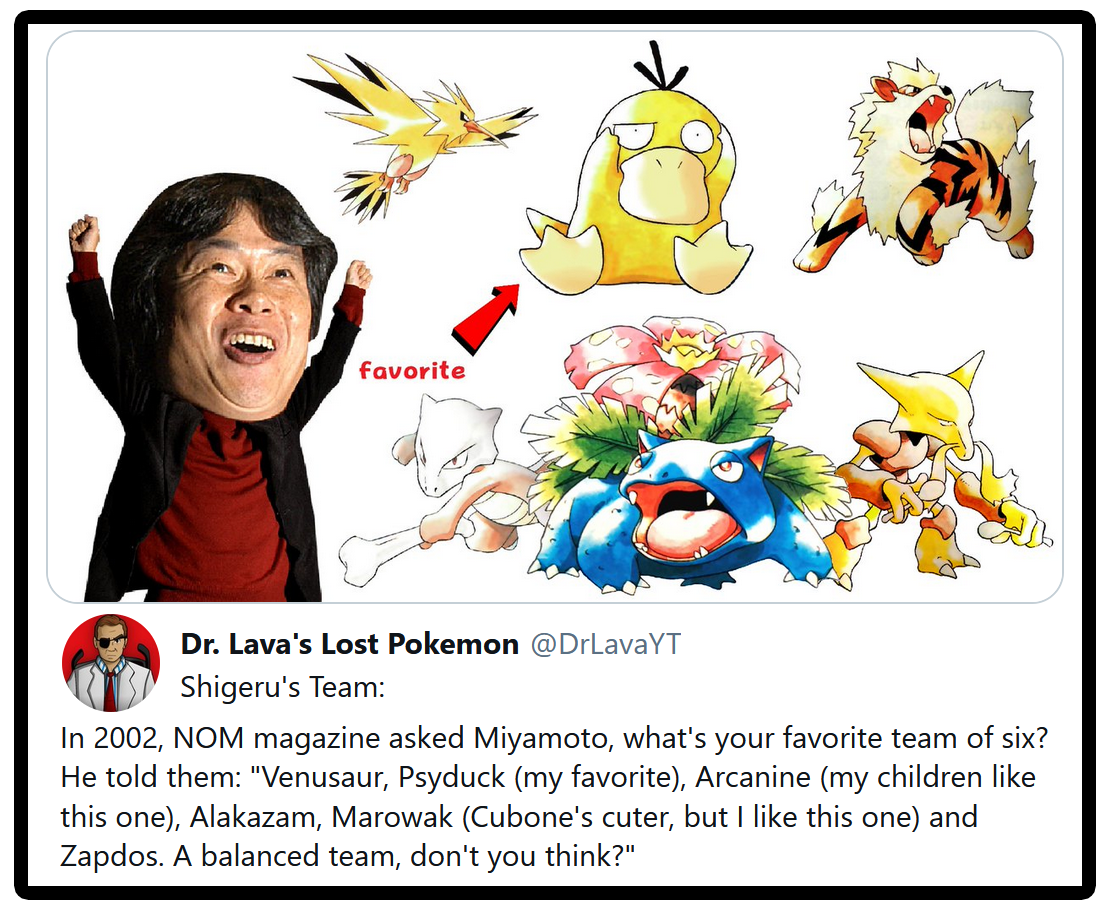
Satoshi Tajiri Talks Red & Green’s Development
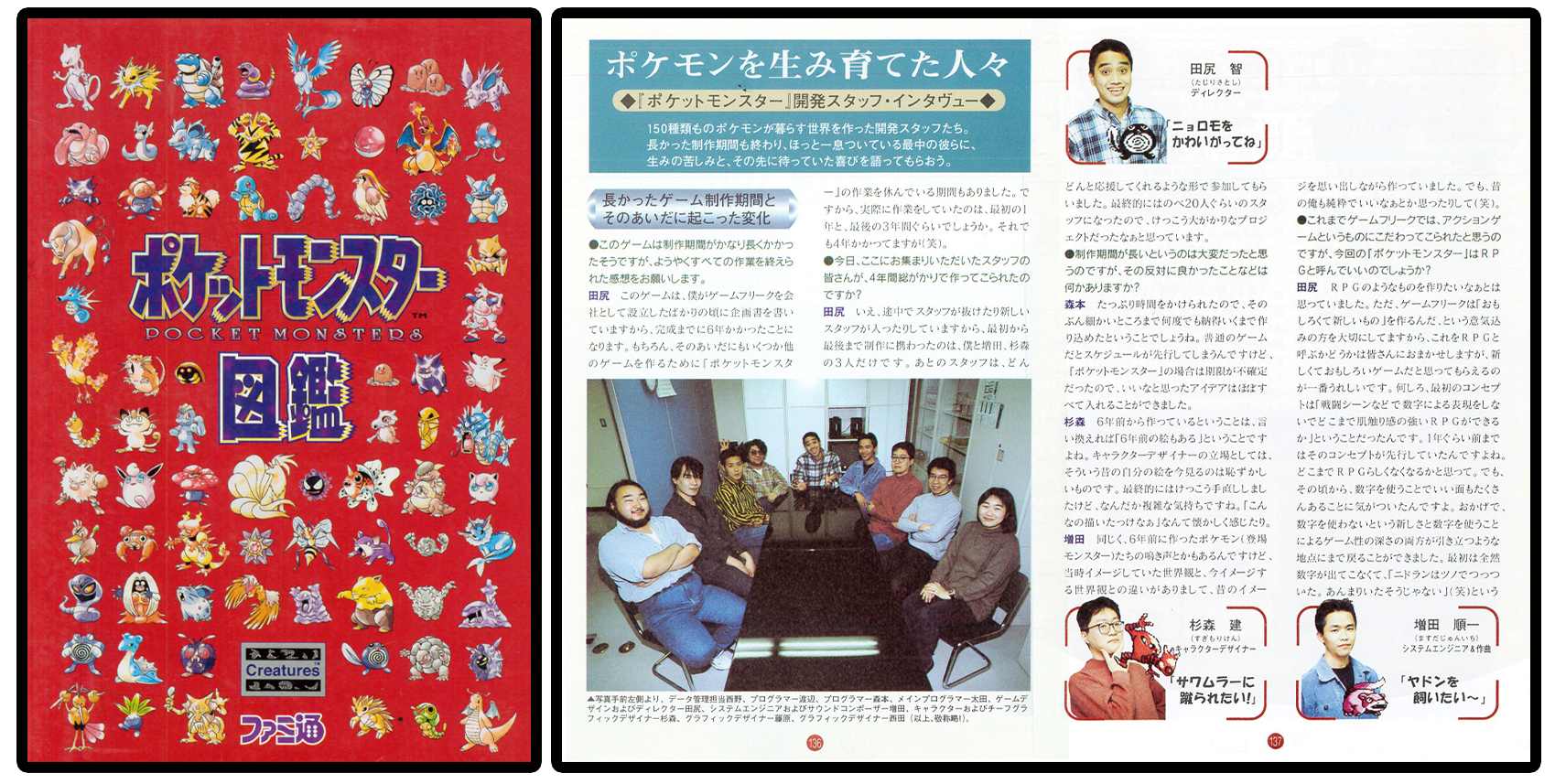
Written by Dr Lava • April 23, 2021
Satoshi Tajiri and Ken Sugimori pitched the Pokemon concept to Nintendo in 1990, then after six long years of development, finally released Pokemon Red & Green on February 27, 1996. Two months later, Creatures published an official Pokemon book called Pokédex, which contained about 120 pages of development info, lore, and original artwork. Tragically, Pokédex was never officially localized outside Japan — but I’ve hired a couple translators to help unofficially localize the book’s highlights.
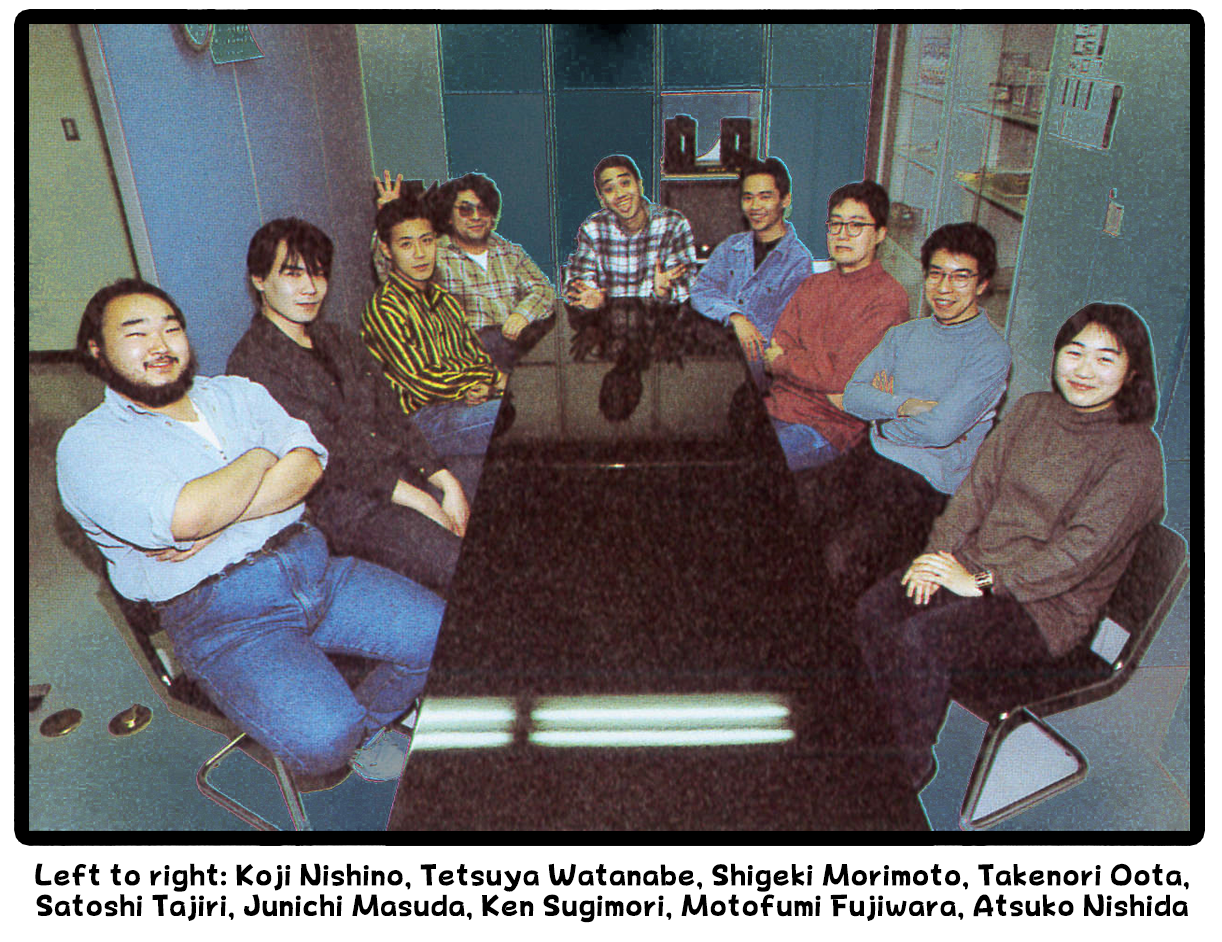
This article is a translation of the book’s 8 page interview with Tajiri and most of his team — including planner Koji Nishino, programmer Tetsuya Watanabe, programmer Shigeki Morimoto, main programmer Takenori Oota, composer Junichi Masuda, art director Ken Sugimori, designer Motofumi Fujiwara, and designer Atsuko Nishida. These are their official titles, but job roles blurred together and everyone did a little bit of everything during development. Like a lot of interviews, the most interesting parts are revealed in the second half — highlights include a scrapped mechanic for Pokemon monetary values, the fact that battles almost weren’t included in the game, and that Miyamoto himself saved 80% of the Pokemon from getting cut.
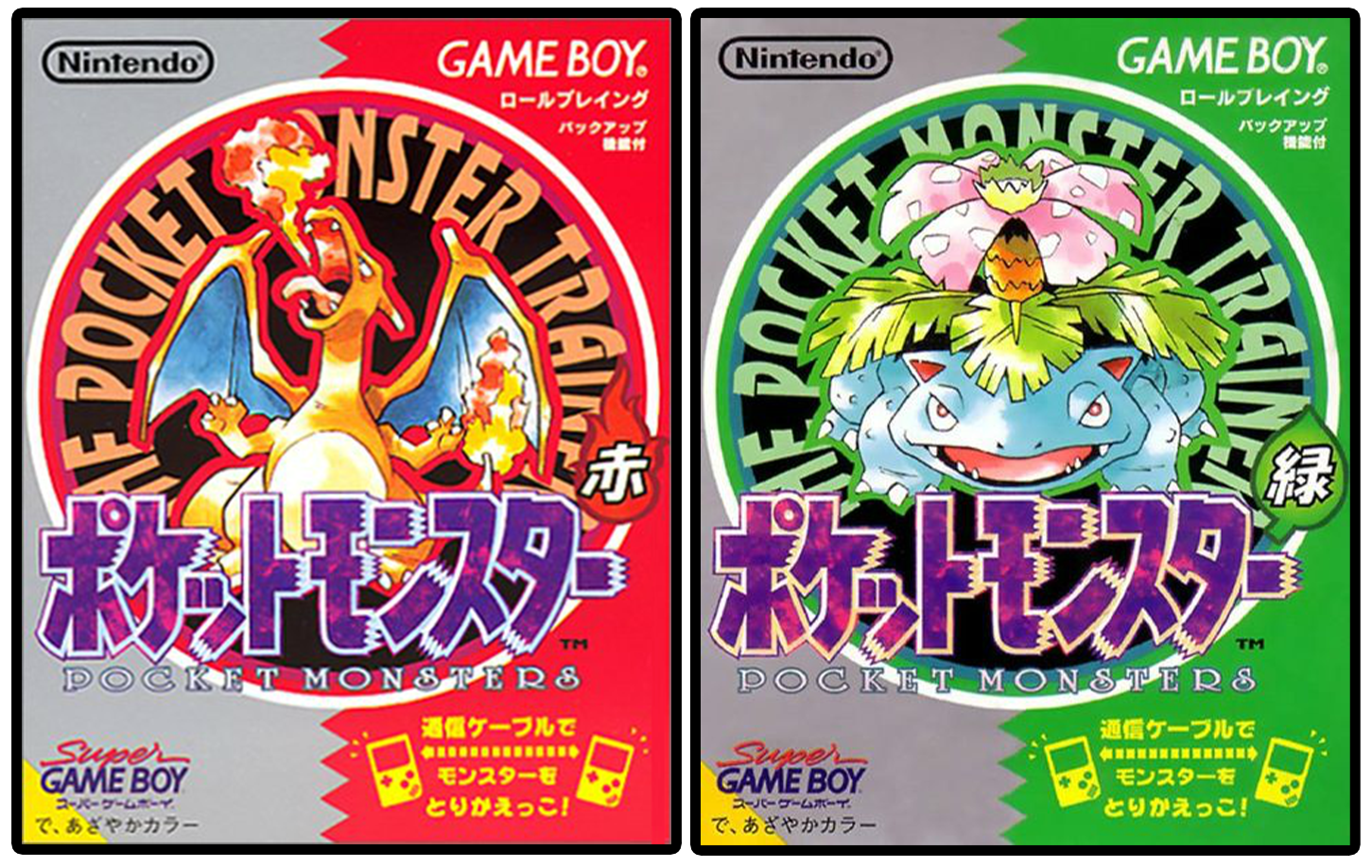
Keep in mind that at the time this interview was conducted, no one knew Pokemon was going to be a success — the developers were all just glad to have finally finished the game. They also talk about there only being 150 Pokemon, because at this point in time, Mew’s existence was still a secret. Okay so without further, here’s the translation.

The Long Development and the Changes That Occurred Within
“Since this game’s development cycle was quite long, I’d like to hear your thoughts on it finally being over.”
Tajiri: “We’d been planning this game since I founded Game Freak as a company, so it’s been a total of about 6 years. Of course, there were phases during that 6 years where we took a break from Pokemon to work on other games. So really, it was the first year and the last 3 years where we were actively working on it. So that still means it took us 4 years.”
“So have all the staff members here today been working on Pokemon the entire 4 years?”
Tajiri: “No, some staff members left and new ones joined in the process, so the only 3 who were here from beginning to end were me, Masuda, and Sugimori. The other members gradually joined in over time. We ended up with about 20 staff members in the end, as it ended up being a pretty big project.”

“It must be challenging to have such a long development cycle — but on the other hand, were there any positive elements to it taking so long?”
Morimoto: “It meant we had plenty of time to squeeze in lots of little details. Normally in game development the schedule takes precedence, but since Pokemon didn’t have a release deadline, we were able to add in just about every good idea we came up with.”
Sugimori: “We’d been working on Pokemon for 6 years, which means at the end we had designs that were 6 years old. The Pokemon designers were embarrassed to see their old creations from early in development. A lot of improvements were made by the end, but it’s a complex feeling. It’s nostalgic to think ‘I drew that.'”
Masuda: “Likewise, we have the Pokemon cries we made 6 years ago, but our vision of the Pokemon world has changed a lot since then. I tried to remember my early ideas later in development, but the old me was a little less imaginative.”

Dr Lava’s notes: A lot of the early Pokemon designs were indeed pretty rough. Here you can see early designs for Ivysaur, Clefairy, and one of the Pokemon who didn’t make the final cut, Kurokki (Crocky). Many of those early designs were polished up during development, but many of the sprites that made it into the final game still dated back to those early days in development. All the sprites from Red & Green were replaced with brand new sprites when Blue released about 9 months later, and those were the sprites used in international versions of Red & Blue.
“Game Freak has mostly developed action games up until now, but would it be better to describe Pokemon as an RPG?”
Tajiri: “We originally set out to make something like an RPG. At Game Freak, what we care about is making things that are ‘new and interesting,’ so it’s up to you all to decide if it should be classified as an RPG or not. As long as you think it’s a new and interesting game, that will make me happy. Our initial concept was ‘to make a game that felt like an RPG, but without too many numbers during the battle scenes.’ That concept took precedence up until the last year of development, but at some point it transformed into something less like a typical RPG. That’s when we realized there were lots of engaging ways to use numbers. This led us to striking a balance between a new experience that avoided too many numbers, and using numbers to create game depth. At first we weren’t using numbers, so in-battle there was text like, ‘Nidoran poked you with its horn. It didn’t seem to hurt that much.'”
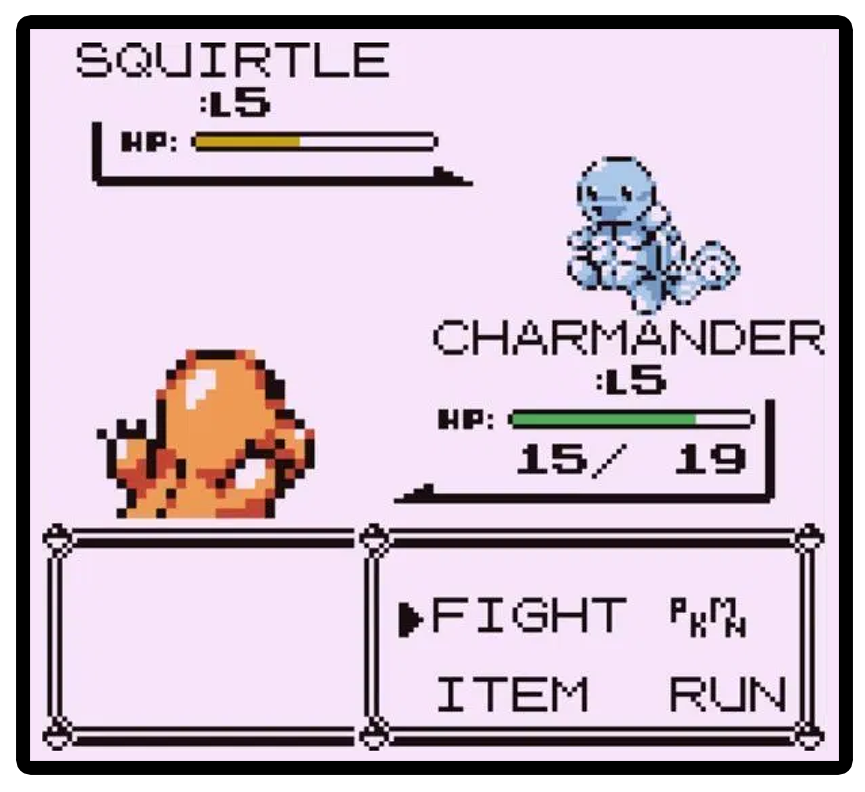
Every Staff Member Put Their Skills to the Test
“Pokemon’s world map isn’t just a large continent of ever-expanding land — instead, it’s punctuated by roads.”
Tajiri: “We had that idea back when there were only 3 or 4 of us on the project. We thought about how the real world we experience is made up local roads, highways, and lots of named roads that connect towns and cities. We figured ‘well why not make a game like that?’ And that’s how we designed Kanto. This also had the advantage of making it so we didn’t have to fill every inch of the map, the way we would’ve had to otherwise.”
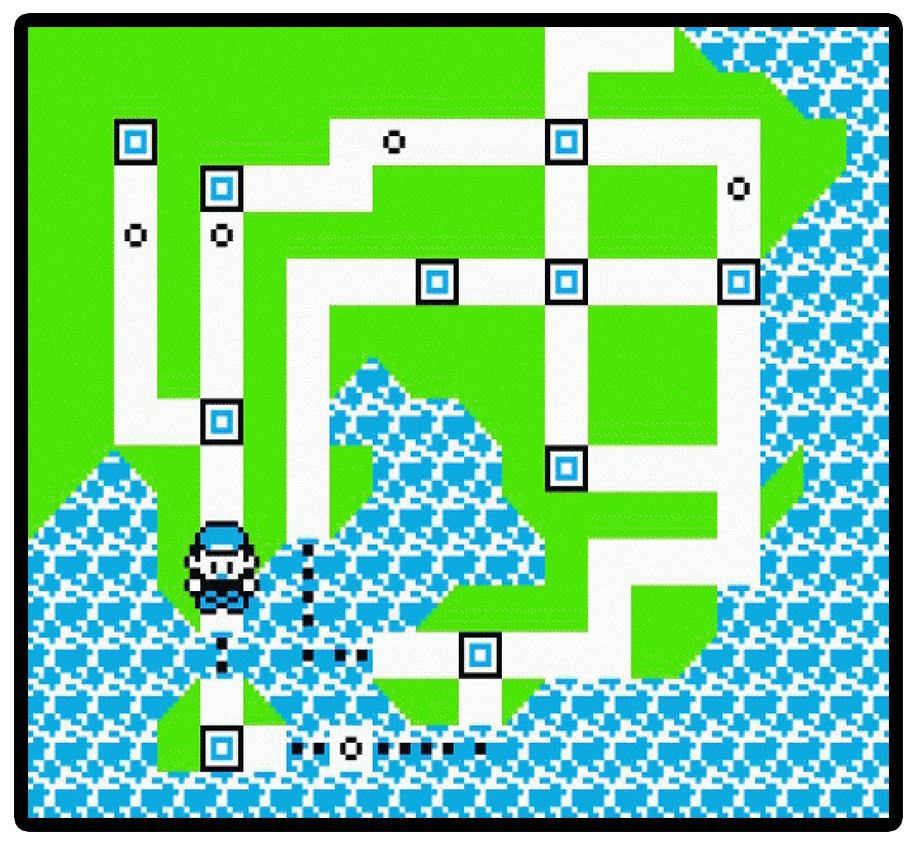
“Of course the gameplay is key, but I can really sense where each staff member contributed ideas, like little details in the battle scenes.”
Tajiri: “Sugimori, Fujiwara, and Morimoto were all working on the Pokemon designs when we started out, but eventually Morimoto decided he’d rather work on programming. He started with zero programming experience, but worked his way up to being the main programmer on the battle scenes.”
“Wow, what a guy. That’s impressive.”
Morimoto: “Pokemon was my first time doing both graphic design and programming.”
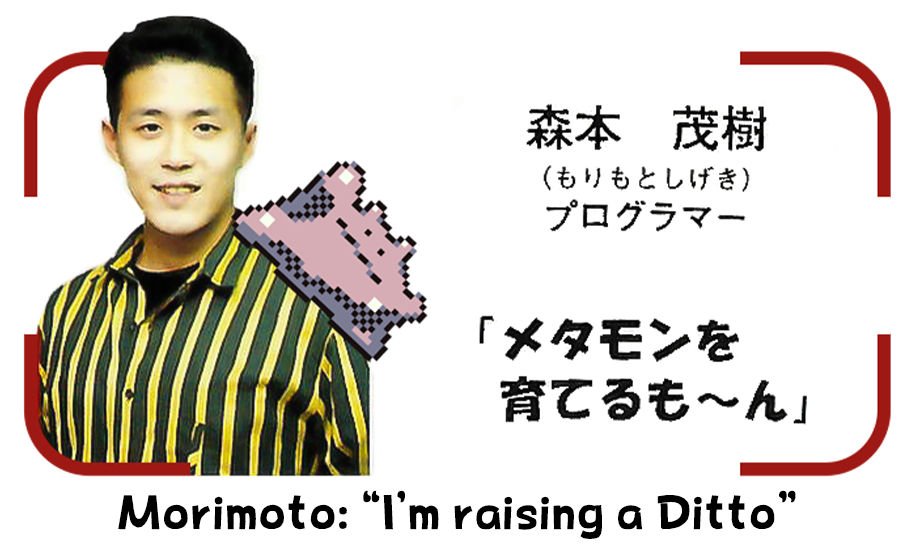
Dr Lava’s notes: As Tajiri mentioned at the start of this interview, not every member of Game Freak stuck around till the end of Pokemon’s six year development. In 2018, a 153 page biographical manga was released in Japan telling Tajiri’s life story. Pages 112-119 briefly touch on a low-point in development when all three programmers quit at once, leaving Morimoto and the rest of Tajiri’s inexperienced staff scrambling to pick up the pieces. You can read these eight pages below — just remember you’re meant to read manga right-to-left, not left-to-right. In case you can’t tell, Tajiri’s the guy in the tie who swears, and Sugimori’s the guy in the glasses who slams the papers. A big thanks to my friend HiResPokemon for providing these scans, and also to my translator Jacob Newcomb.
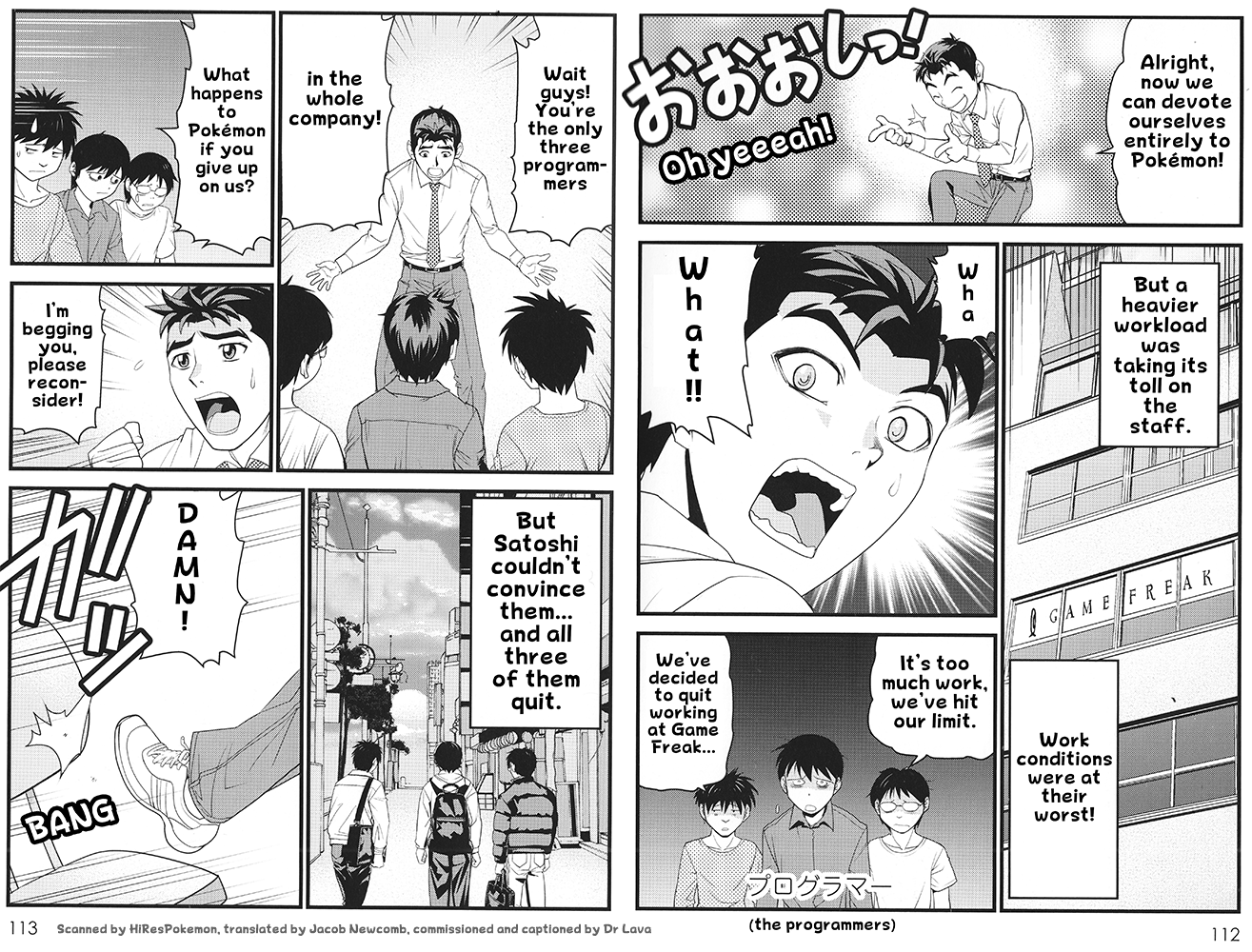
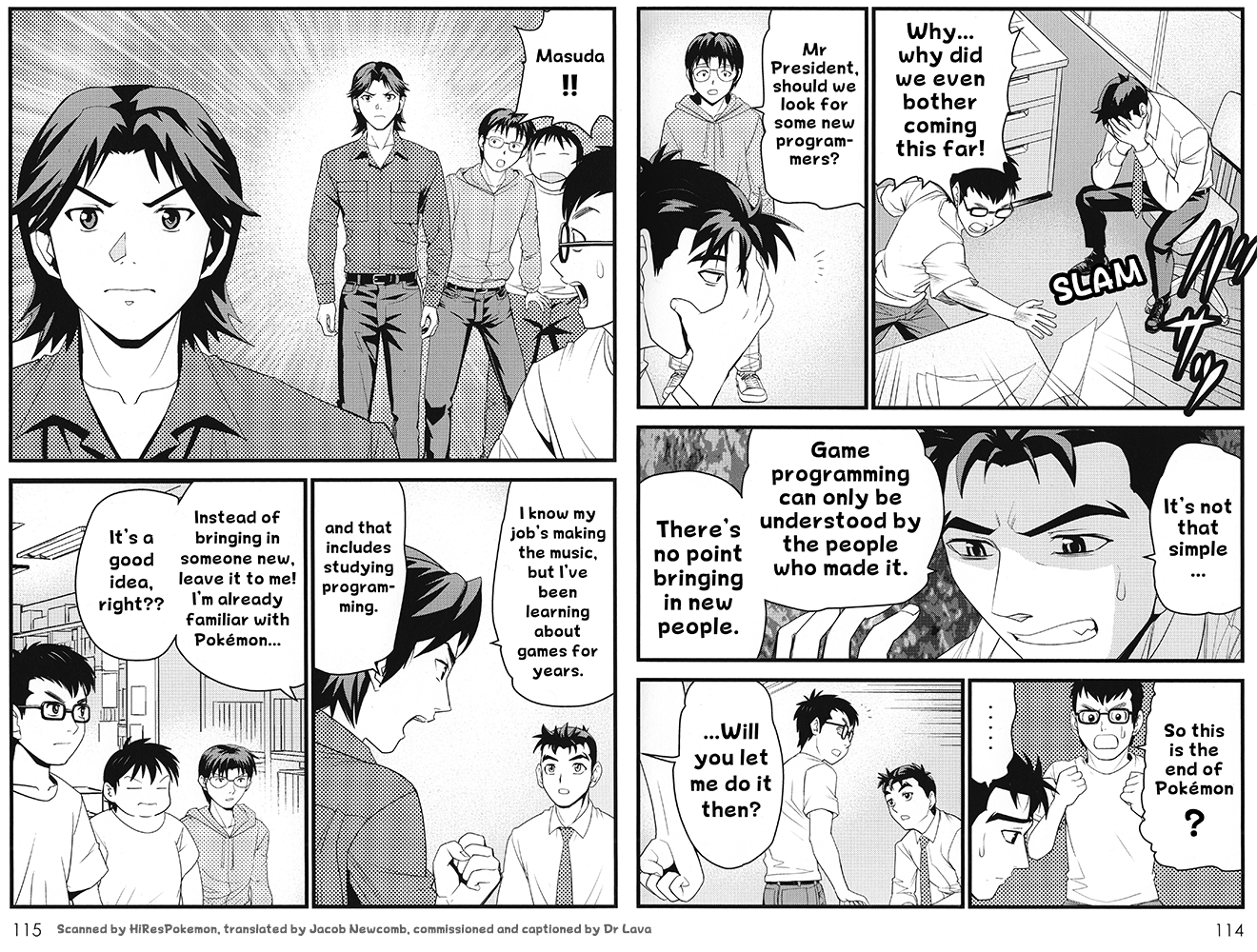
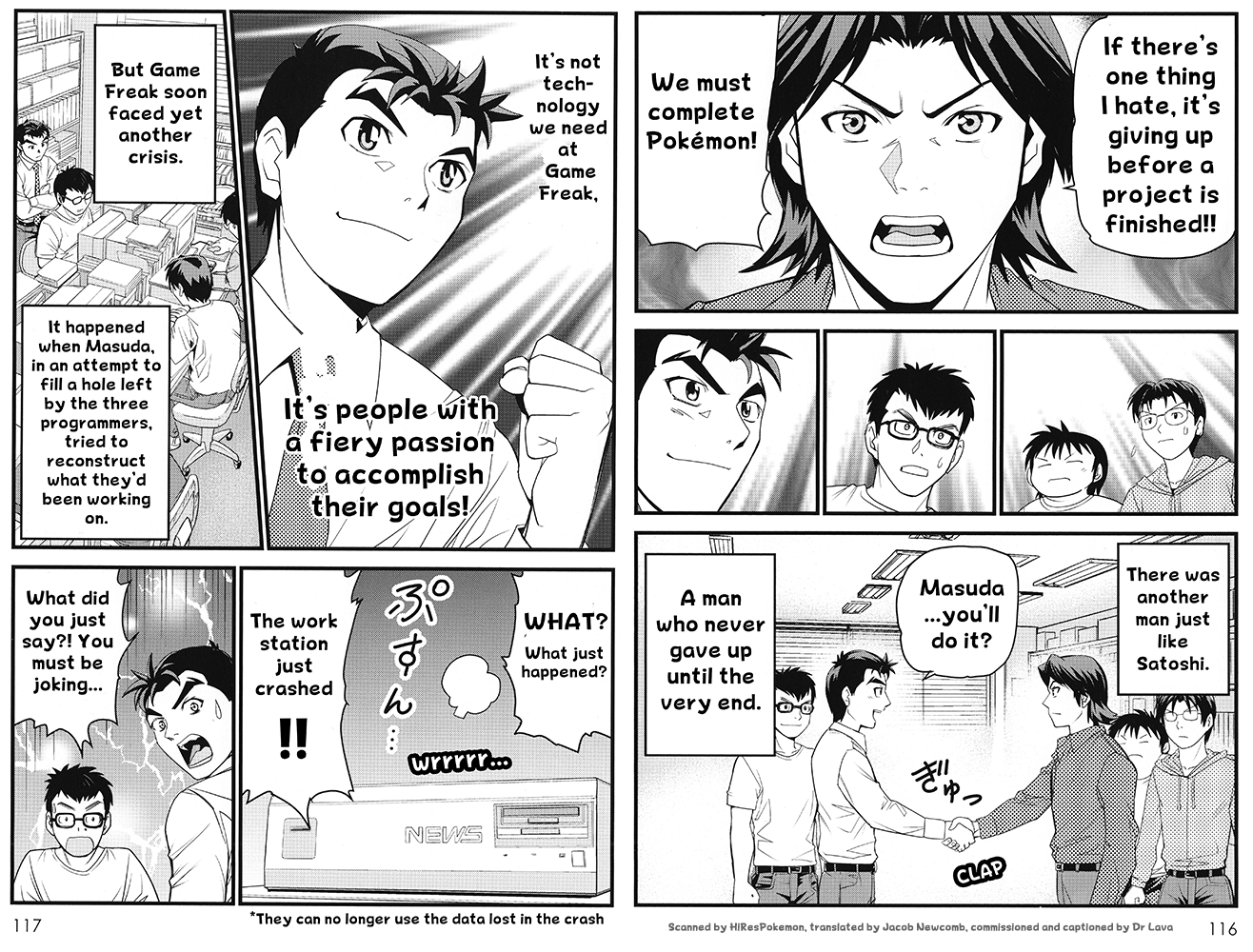
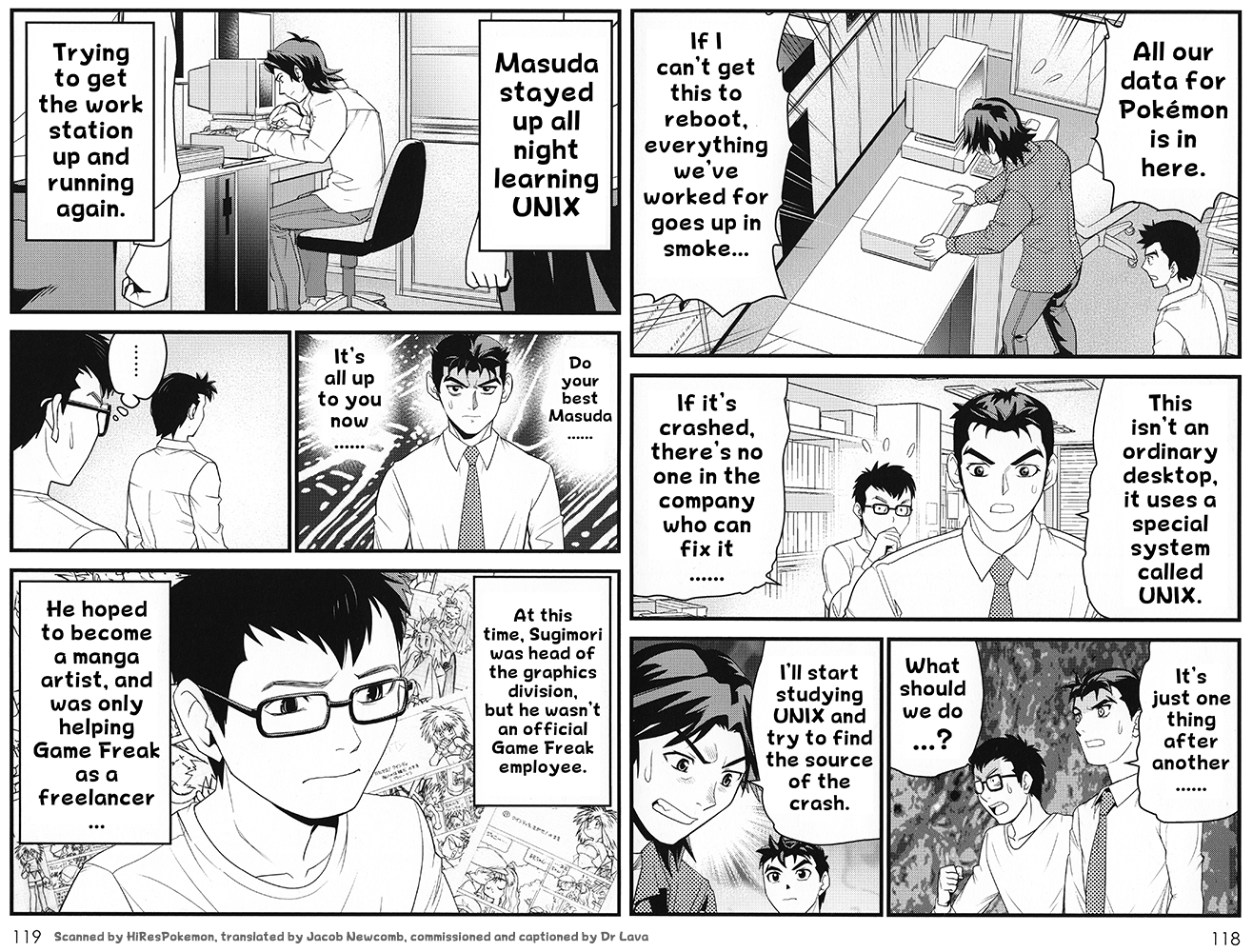
Considering the circumstances, it’s not surprising Gen 1 ended up containing so many bugs and glitches — the Mew glitch, MissingNo glitch, and countless others. Eventually Watanabe and Oota came on board as well. Imagine being one of those three programmers that quit, only to find out a few years later that Pokemon sold nearly 50 million copies. Facepalm. By the way, that last panel probably leaves you wondering what happened to Sugimori. That’s a story for another day that doesn’t overlap with this Pokédex interview so we won’t dwell on it, but the short version is that he ultimately gives up his dream of becoming a manga artist to join “the Game Freak family” and help Tajiri see Pokemon’s development to the very end.
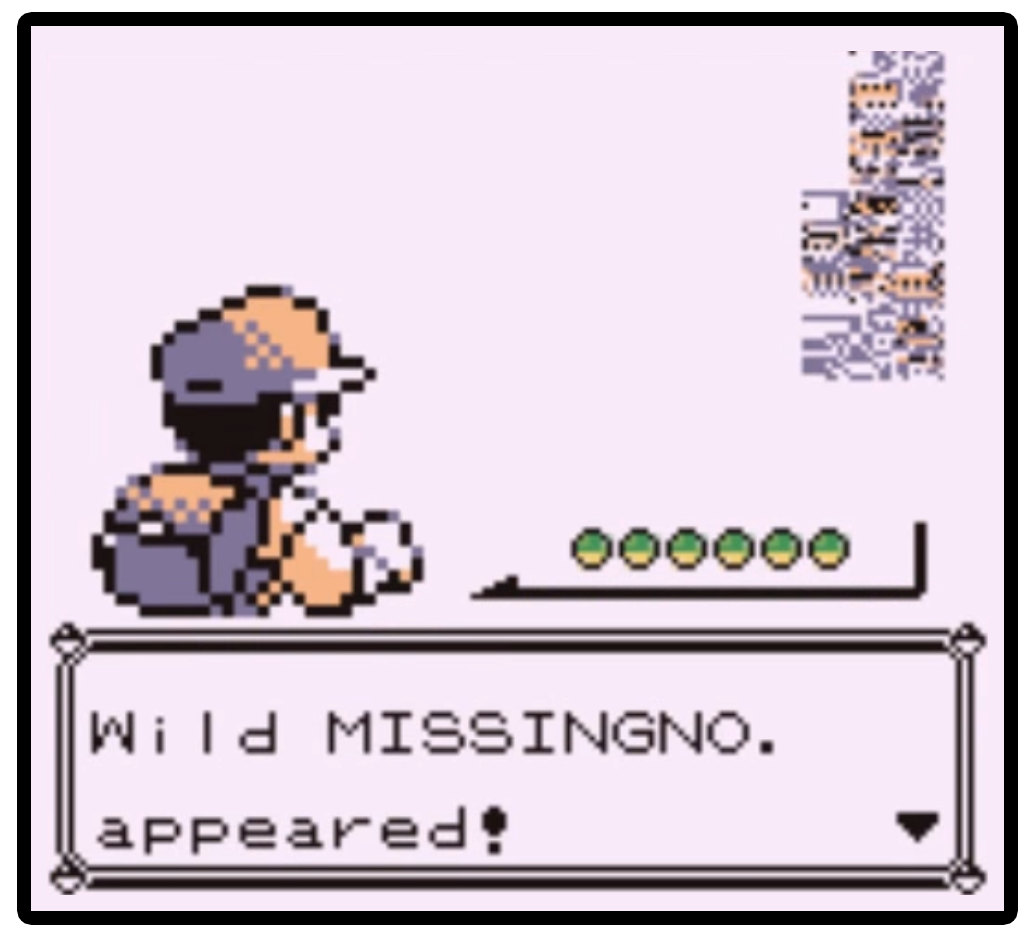
Tajiri: “To make these battles as immersive as possible, there’s actually a lot of numbers and programming behind the scenes that you don’t see. It was getting overwhelming for me to manage, and that’s when Nishino stepped in. He was like my stage assistant, and he really helped me out.”
Nishino: “This was also my first time working on a project like this. We just kind of improvised as we went along… well really, if they noticed something needed doing, they’d just make me do it.”
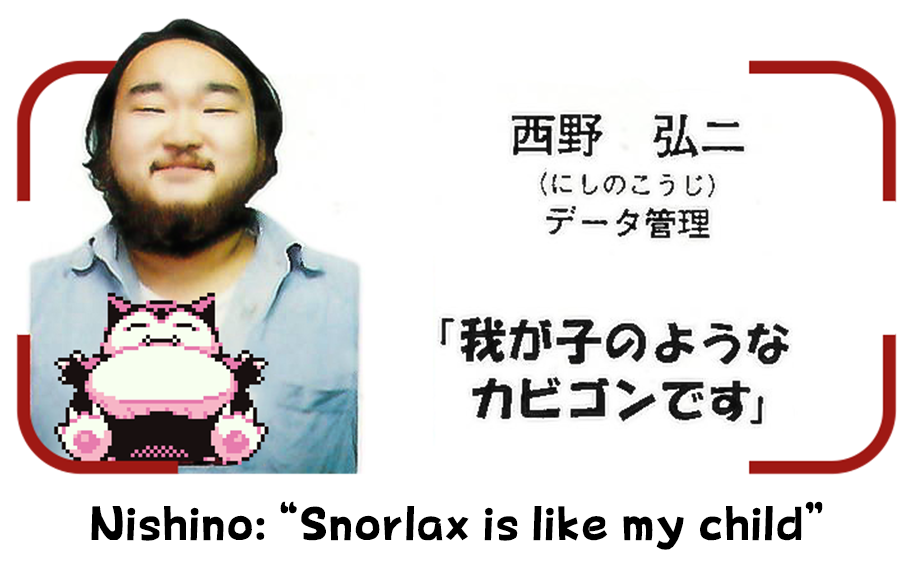
Watanabe: “Because no one else wanted to do it. (laughs)”
Tajiri: “He started out as just a helper, but ended up becoming an indispensable part of the team.”
Oota: “Nishino only ever took one day off, and programming just ground to a halt without him. It was Nishino who had all the information.”
Morimoto: “Nishino was also the guy who was most knowledgeable about RPGs, and he left his mark on the data administration side of things as well.”
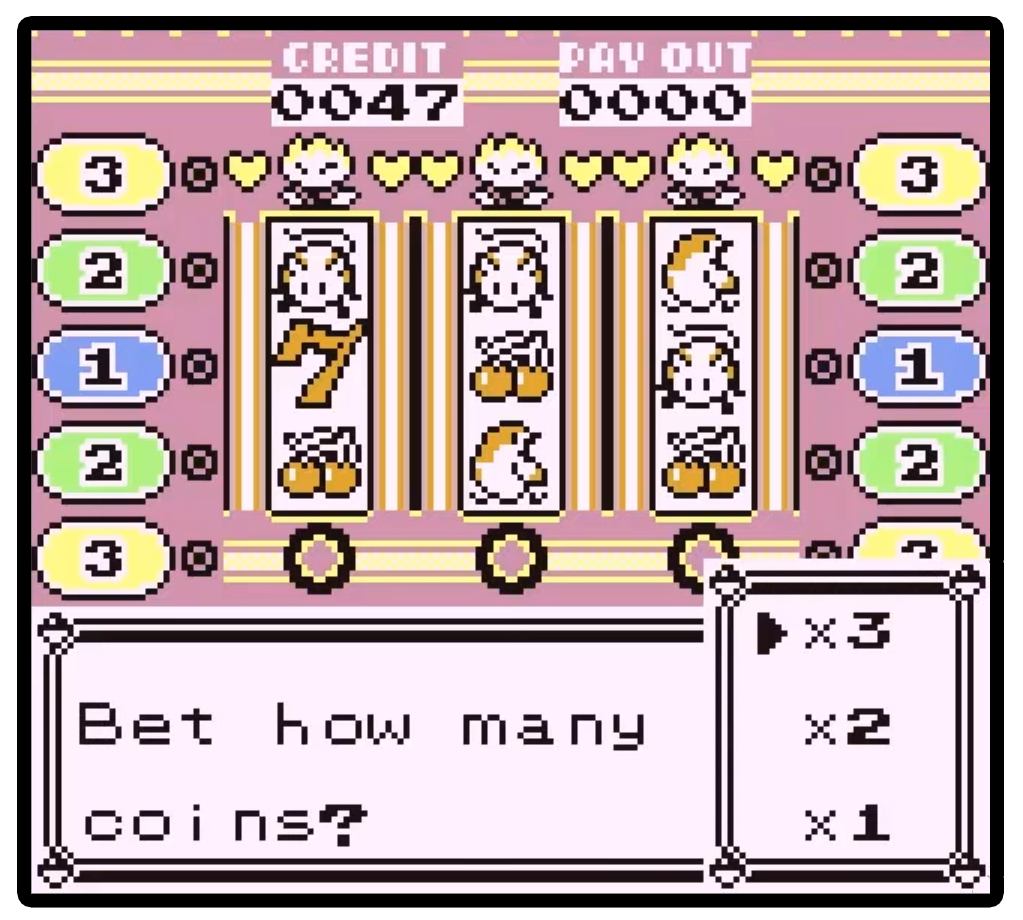
Tajiri: “Every staff member brought their own style to this job, but as the director, that sometimes made it hard for me to gather everyone’s opinions. But on the other hand, this allowed us to add in the charm of lots of different games to make a good final result. For example, we have slot machines included as a minigame, and that only happened because one time in a meeting Watanabe said ‘I decided I wanna add gambling.'”
Watanabe: “I didn’t say it like that. (laughs)”
Tajiri: “Developing Pokemon wasn’t me telling everyone what job to do — really, it was more like each staff member taking responsibility for what they felt most passionate about.”
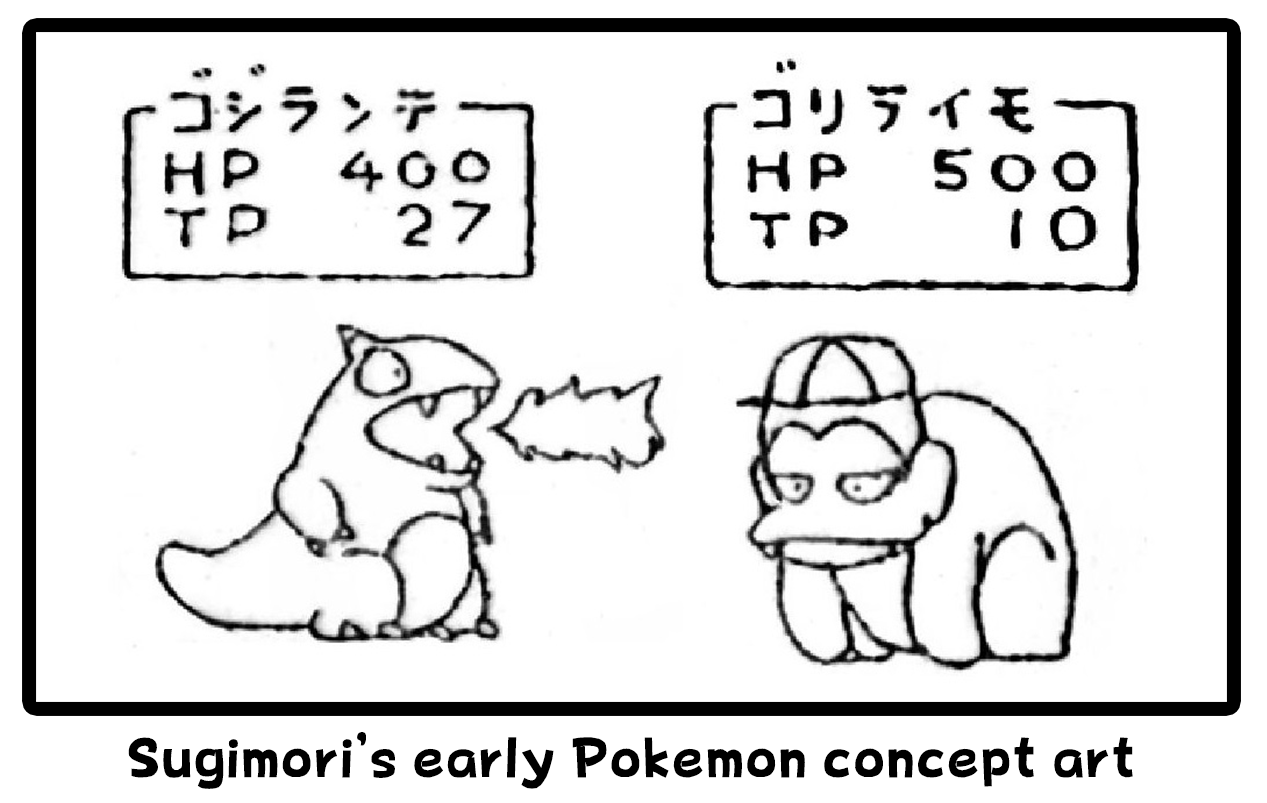
What Are Your Thoughts on Kaiju?
“Pokemon are a bit different from kaiju, but the Pokemon concept definitely has strong ties to memories of kaiju TV shows we all watched when we were kids. Can you expound on that?”
Tajiri: “To be honest, the capsule kaiju from Ultraman were a big influence on me. I also enjoyed Akakage.”
Sugimori: “I preferred the protagonists like Ultraman over the monsters. When I was a kid, I drew pictures of superheroes I came up with myself.”
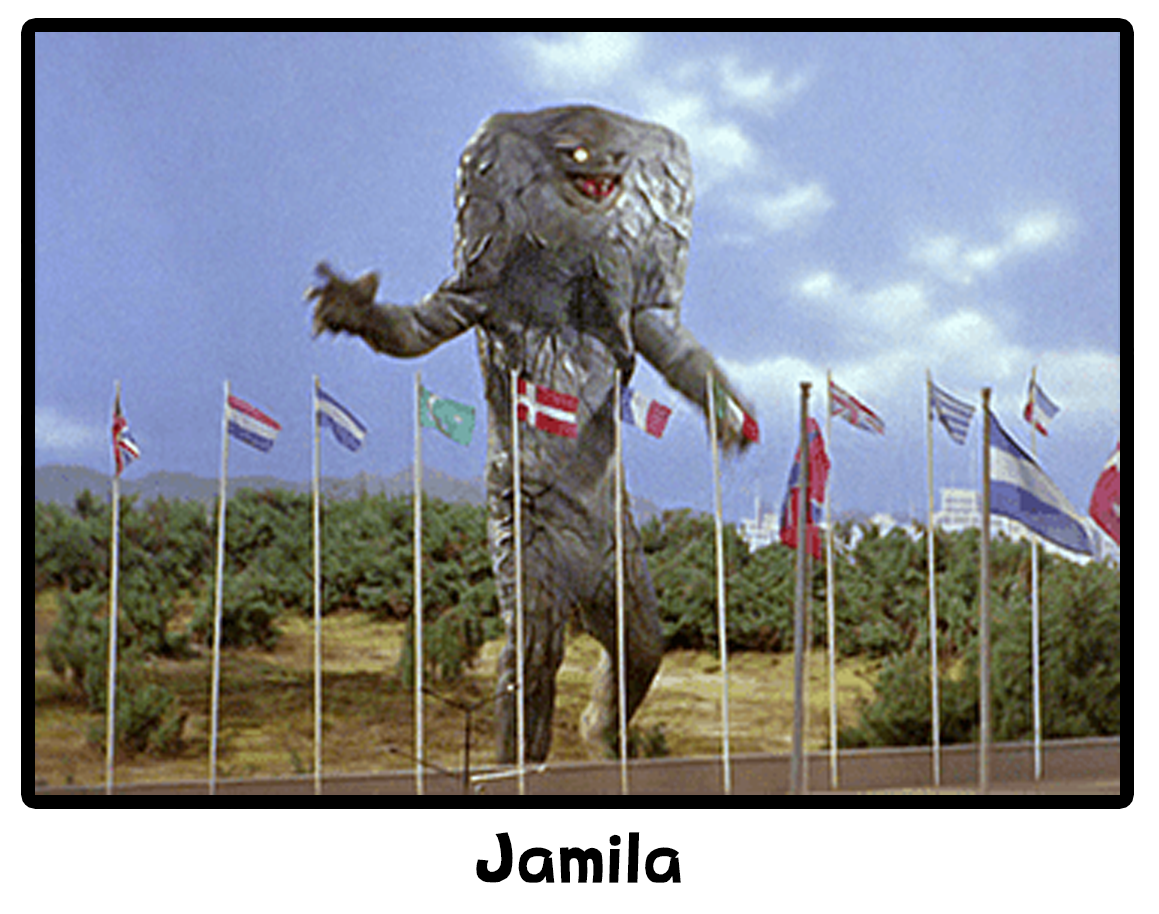
Oota: “I always loved the kaiju Jamila, and I used to pull my t-shirt over my head so I looked like him. (laughs)”
Watanabe: “I also liked kaiju, but I was more interested in animals that actually exist. Horses are my favorite, for a few different reasons.”

Fujiwara: “I absolutely love the kaiju from the first half of the Ultraman series. The second half on the other hand…….”
Nishida: “I ended up appreciating how cool kaiju are later on, but I hated Ultraman as a kid. Normally I prefer the heroes over the monsters. (laughs)”
Dr Lava’s notes: Pokemon was originally supposed to be called Capsule Monsters, but due to copyright issues, they had to change it to Pocket Monsters. In the 1960’s TV show Ultraman, the hero uses “capsule monsters” stored inside “monster balls,” which he throws to release them and battle kaiju. Sound familiar? You can see an example from the show in the video embedded above. According to Ken Sugimori, the earliest Pokemon designs were all based on kaiju, although many ended up getting cut in development. A lot of them made it into the game though, and are still being produced to this day — like Nidoking, Tyranitar, and Volcarona, just to name a few examples.
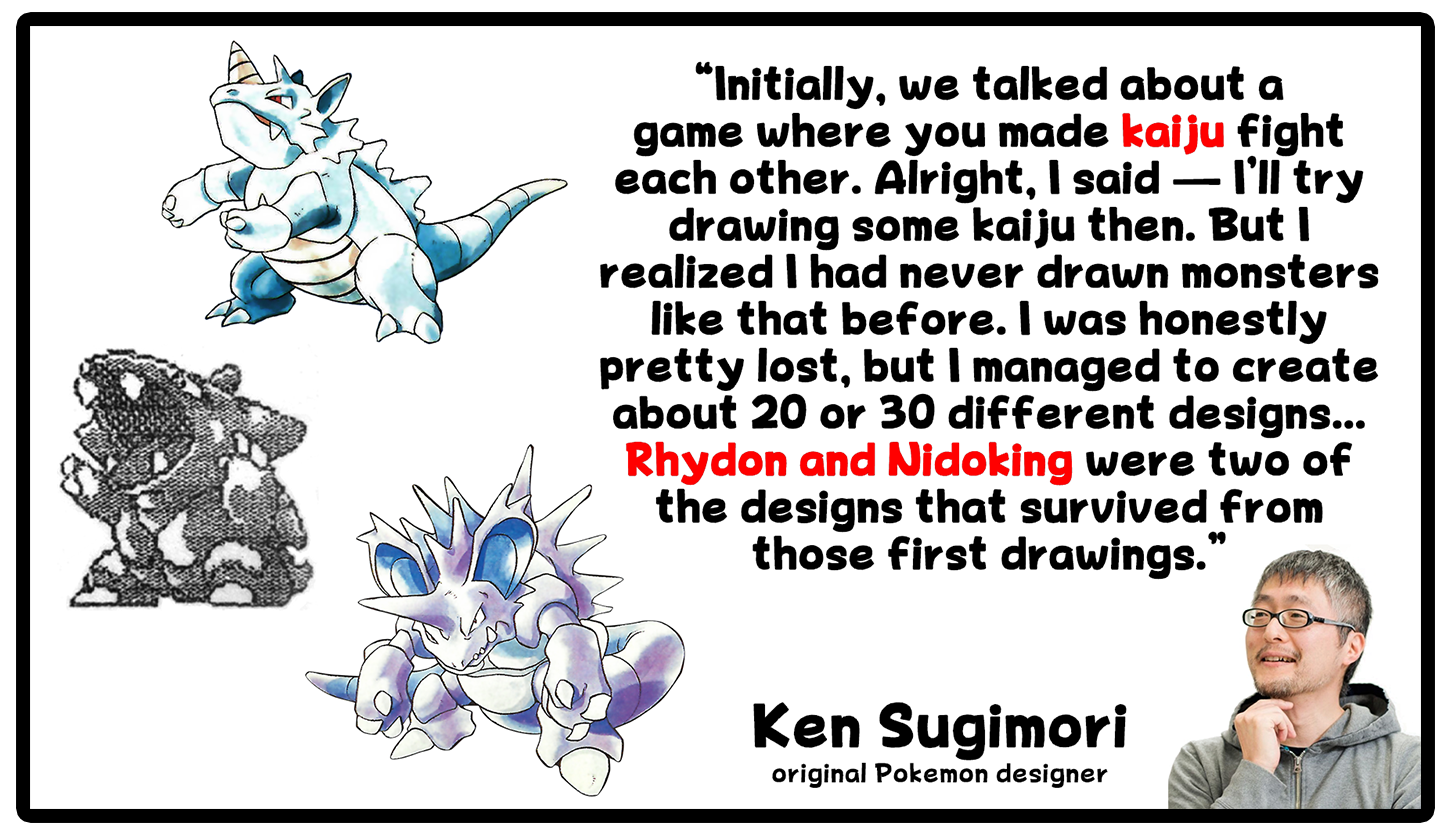
A Mountain of Ideas Discarded to Keep Trading Fun
“When did you come up with the idea to make collecting and trading part of Pokemon?”
Tajiri: “The moment I saw the Game Boy, the link cable really captured my attention, but at the time most games only used it for battling. But I feel the word ‘connection’ has a rather beautiful array of meanings to it, and I thought the link cable could be used to transfer all kinds of information like TV or radio. I had a feeling we could do something interesting with it, and that resulted in a system where you can trade the creatures you’ve raised.”
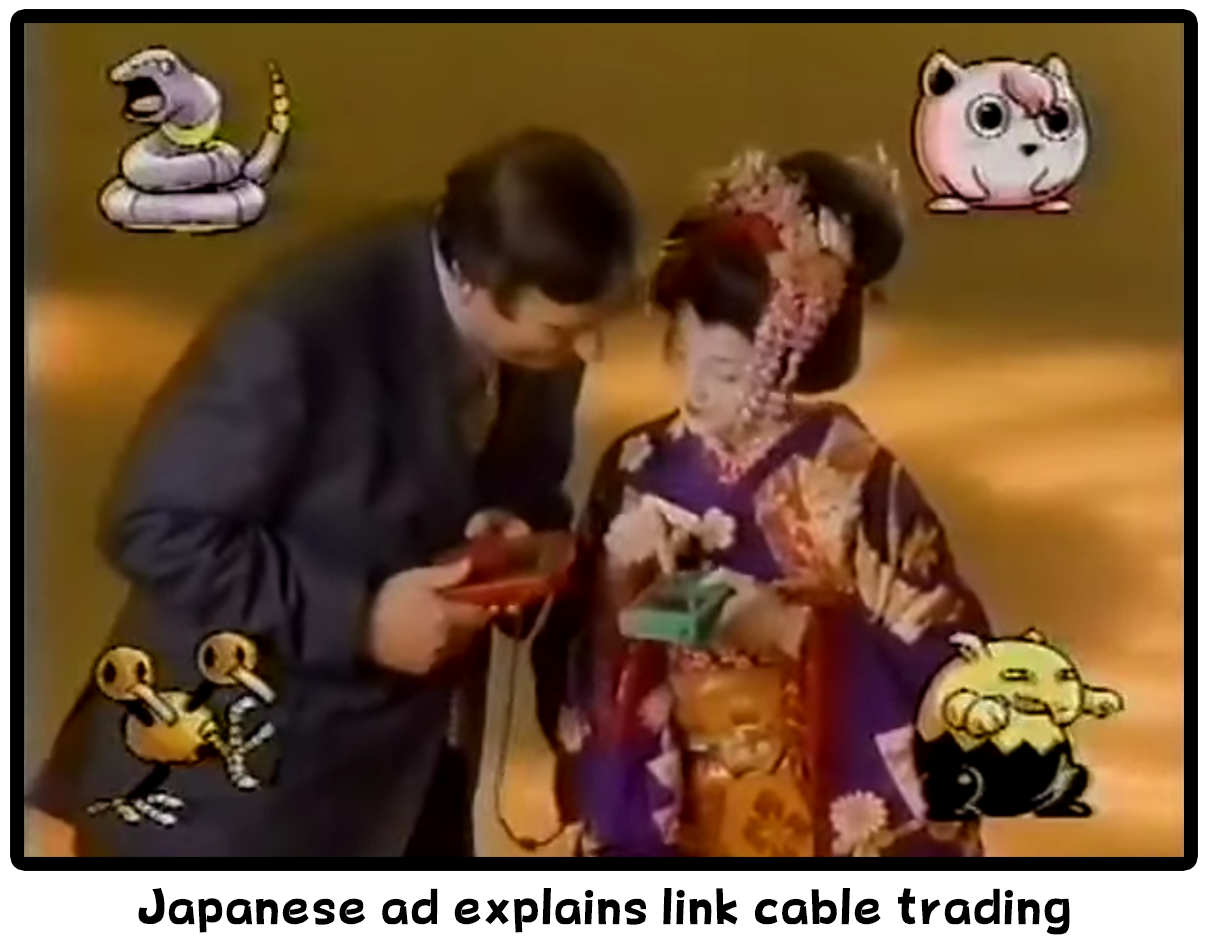
Sugimori: “We thought it would be cool if you could find something rare, then show it off or trade it.”
Tajiri: “For example, in Dragon Quest, there’s a rare item called the Mad Cap — and Sugimori was talking about how he had two of them. I’d spent so many days trying to get a Mad Cap of my own, but I just couldn’t get one. So I just thought, “well since he has two, why can’t he give me one?” So our original idea for Pokemon wasn’t ‘we want to make an RPG’ — instead, it was ‘we want to trade.’ The fact it’s an RPG came later.”
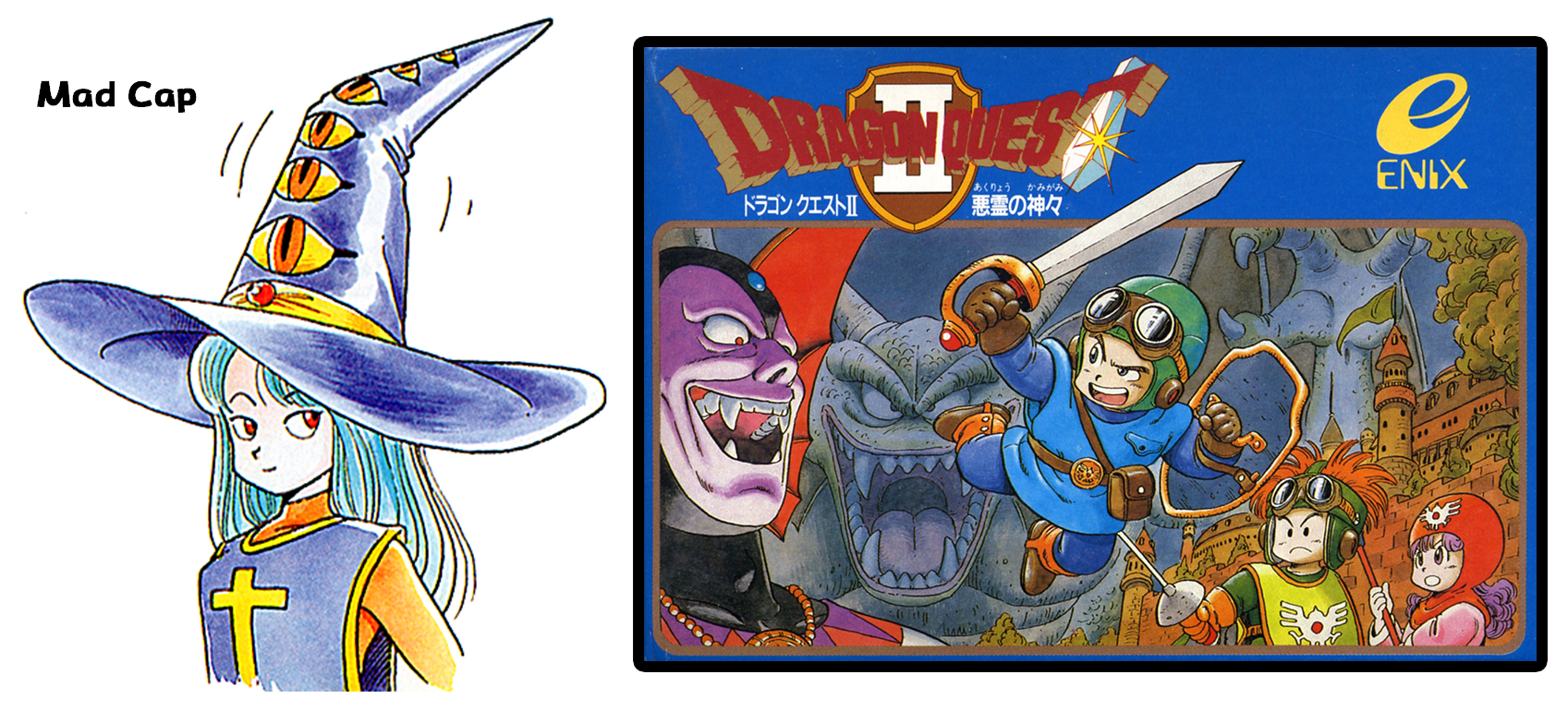
Dr Lava’s notes: The Mad Cap appeared in several Dragon Quest games, starting with 1987’s Dragon Quest II. They were both incredibly useful as well as incredibly rare — Mad Caps are only dropped by certain enemies, and with a drop rate of only 1/128. According to Tajiri, the rarity and desirability of Mad Caps are what inspired to him to make a game based around trading with the link cable. Put another way, if Mad Caps had a higher drop rate, Pokemon might never have happened.
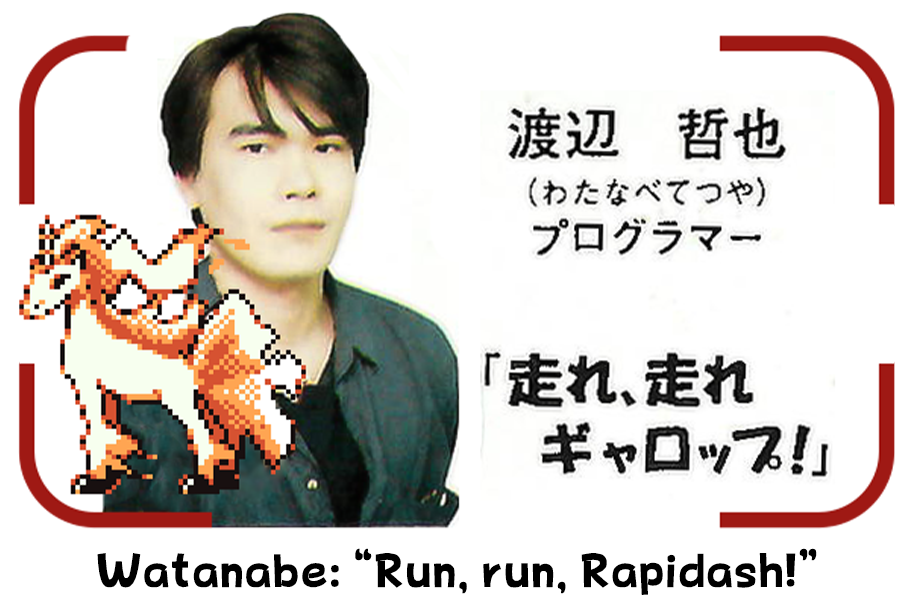
“So being able to trade was more important than it being an RPG?”
Tajiri: “That’s right, but we wanted to make sure both players would trade something of value. In Pokemon’s early development, you could buy Pokemon with money — but that resulted in the player focusing on saving money to buy them, and less motivation to struggle catching them in the wild. We thought about that, and started to get a better idea of the type of game we wanted to make little by little. We also thought about making one player pay money in addition to their trade when there was an obvious difference in the value of two Pokemon being traded, but implementing Pokemon monetary values was beyond the limits of our programming. Transferring money in the game is very different from wiring money in real life, and there were difficulties getting it to work on Game Boy — there were just too many obstacles to overcome to make it happen. We had no choice but to focus on what we wanted most and give up on the rest. In this case, being able to trade Pokemon was our top priority, so we cut the monetary value feature. The result is something simple and easy to understand for new players.”
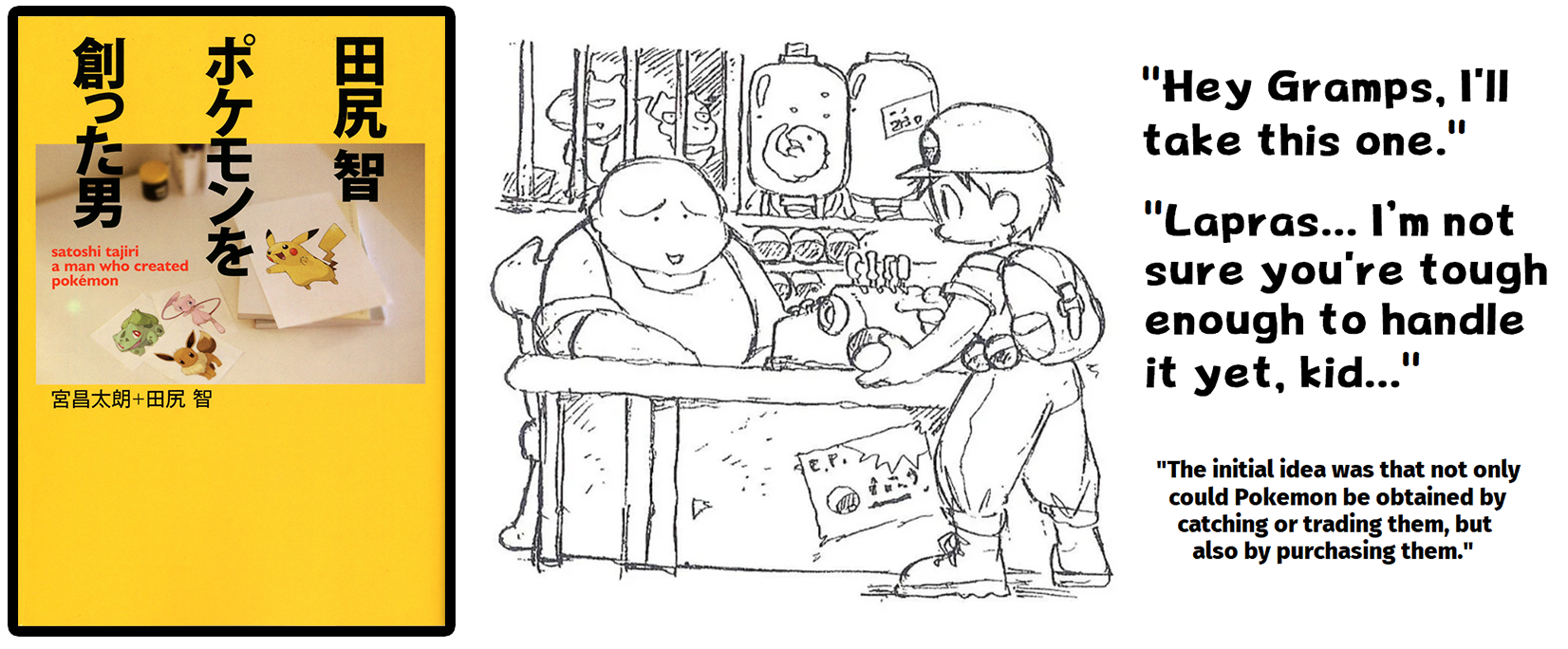
Dr Lava’s notes: In the game’s final build, there are still a few Pokemon you can buy — like a Magikarp for 500 Pokedollars, as well as some Pokemon in the Celadon Game Corner. But buying Pokemon was originally a mechanic much more central to the overall game, as explained here by Tajiri. This idea was also illustrated in some concept art published in the 2009 book Satoshi Tajiri: A Man Who Created Pokemon (translation pictured above).
But what Tajiri says in this interview is particularly interesting — that every Pokemon was originally planned to have a pre-determined monetary value assigned by Game Freak, and if you traded two Pokemon, one player would have to whip out their in-game wallet to pay the difference in value. That would also signal to players which Pokemon are better than others based on their price — essentially ranking Pokemon with an official tier list. It’s also interesting this idea wasn’t scrapped voluntarily, but because Game Freak’s amateur programmers lacked the ability to code the feature into the game. Just think how that could’ve evolved into players hunting for wild Pokemon, then selling them to the shop for cash — kinda like a bounty system. With lots of Pokemon to buy and sell, cash could’ve been a lot more valuable in the Pokemon world. Pretty fun to think about.

The Technical Capabilities Needed to Bring Ideas to Life
“The Pokemon names are more like nicknames than taxonomical names, aren’t they?”
Tajiri: “At first we thought of letting the player name new species they discovered, but the Game Boy has its limits… and yet, we didn’t want to give up on the idea. That concept evolved into being able to nickname your own individual Pokemon. In the middle of production, we conducted a poll, and many wanted to be able to do that. However, implementing the nickname system meant we’d have to reduce the number of Pokemon you could collect. We had about 100 designs we were attached to, but we would have to cut it down to 30. And yet, people really wanted to nickname their Pokemon. So we gave up on having more than 30 Pokemon — but at the last minute, Mr Miyamoto from Nintendo said he’d gift us the RAM needed to include lots more Pokemon. In an instant, we had 4x the capacity to work with. Thanks to that, we were able to include every single Pokemon we’d given up on. I don’t tend to focus on technical capabilities when I’m designing a game, as it’s not the technical capability that gives a game its charm. However, that’s the part of making games that I’m the worst at, because if the technical capabilities aren’t there, the thing I really want to make just isn’t going to be possible.”
“So you didn’t originally think ‘I need a lot of capacity to make this game,’ but you designed the game, then realized “I need to increase the capacity to make it a reality.'”
Dr Lava’s notes: Wow, what a story. So Tajiri’s team was willing to cut the game down to just 30 Pokemon in order to implement nicknames — but Miyamoto himself rode in to save the day at the last minute and give them a better Game Boy cartridge. Just imagine if he hadn’t. The series probably never would have blown up into such a huge success, which means it never would’ve left Japan, and probably wouldn’t have had as many (or possibly any) sequels. And if they had made sequels, they probably would’ve added a lot fewer new Pokemon in each new game — who knows, maybe 30 per generation. You could play the “what if” game all day long with this one.
Just like the programmers quitting, the Miyamoto RAM situation was explained with a few more details in the 2018 Tajiri biographical manga, excerpted and translated below. Remember, read it right-to-left.
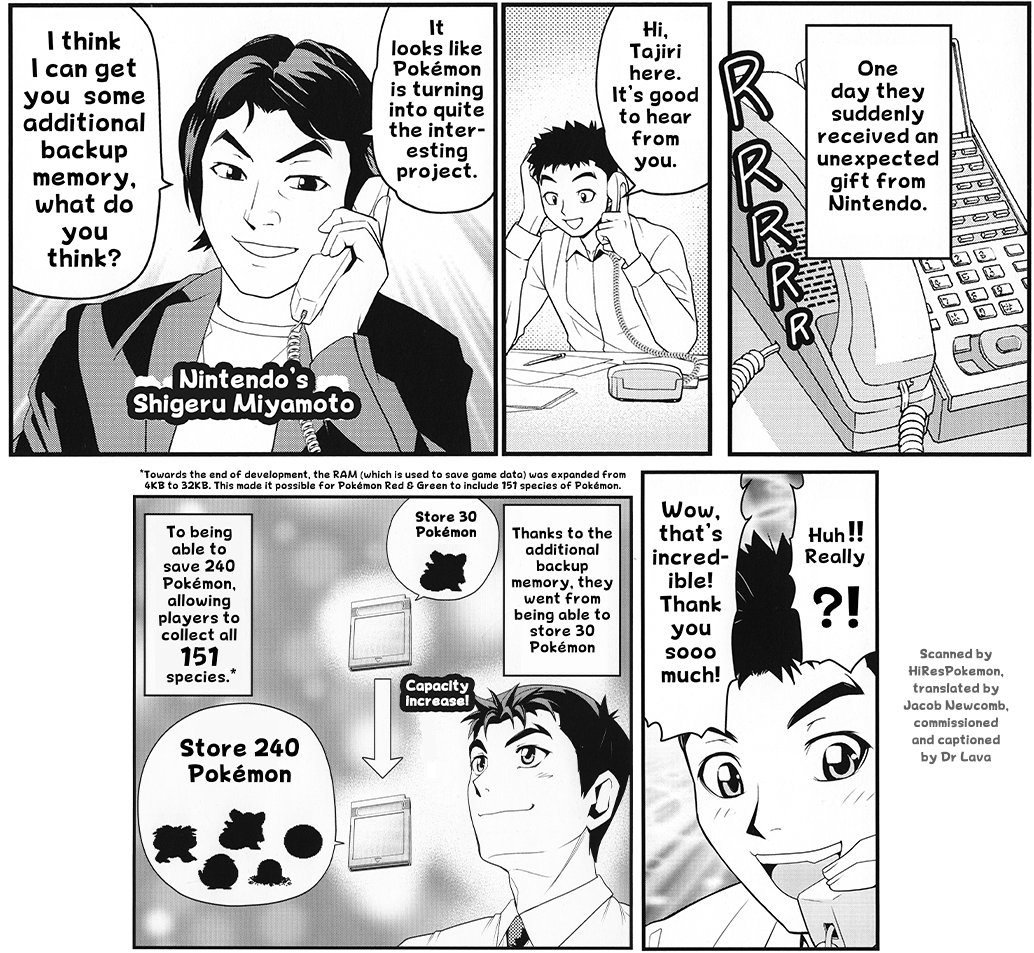
Unfortunately, even after Miyamoto gifted Game Freak additional RAM, they still had to make some cuts to get Red & Green to fit onto cartridges. They had to remove Gorochu and lots of other Pokemon, and according to Ken Sugimori, they also had to remove the ability to have more than one save file per game. They originally wanted to have three save files, but cut it down to one to preserve the nickname feature (a translation of that interview can be found here).

Oh and let’s not overlook the first thing Tajiri said — they originally thought about letting players name Pokemon species when they discovered them. That would’ve absolutely decimated the series’ marketability… just imagine everyone having a different name for Pikachu, Bulbasaur, etc. Thank god that concept evolved into the nicknaming system.
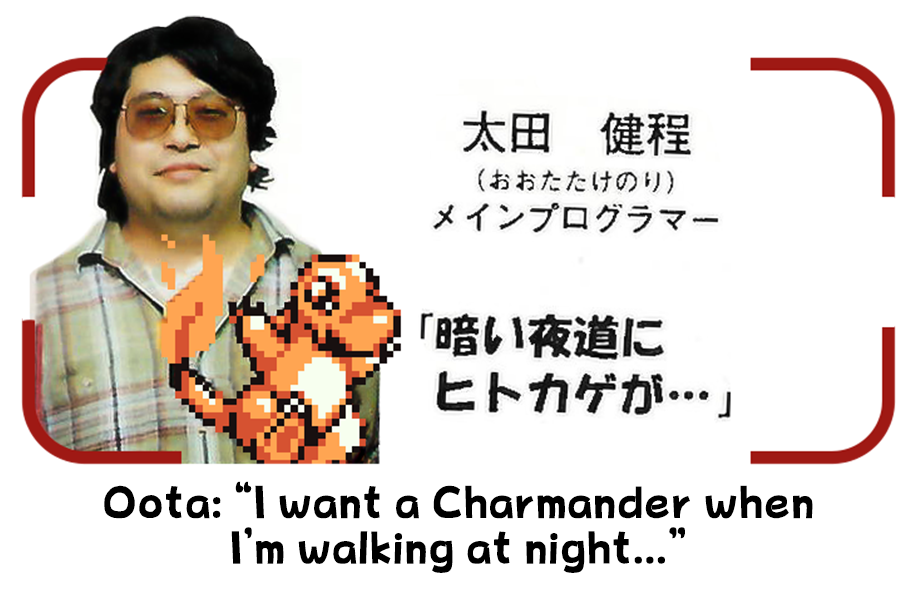
After Trading, Next Comes the Battle System?!
“Different Pokemon appear depending on if you own the Red or Green version of the game — what was the inspiration for that idea?”
Tajiri: “We got the idea from Mr Miyamoto actually. A while ago he came to look at the game, and suggested we ‘give people more reason to want to trade.’ So we thought if we make two different color versions with different Pokemon appearing in them, that will get people excited about trading. It only happened because it was suggested by Nintendo, the idea had never even occurred to us before that.”
Oota: “We also considered having each game generate a random ID number the first time it was booted up, and that number would determine which Pokemon appeared in the game. But that was just an early idea.”

Dr Lava’s notes: That sure would’ve been an interesting alternative to version exclusive Pokemon — a random number generator deciding which Pokemon would appear in each game. It’s worth noting that at one point, Miyamoto wanted to release three versions — but they ended up whittling it down to just Red & Green. Blue of course was released later via Corocoro Comics, which you can read more about in this translation.

Tajiri: “Once we made it possible for trading to occur, our next step was letting people battle.”
Morimoto: “President Tajiri had wanted us to implement battling for a while, but I personally didn’t find the idea very interesting, and just thought it would be a pain to program. (laughs) It looked like we’d run out of time and would have to scrap the battling feature, but Nintendo made it clear they wanted battles in the game, so we had to make it happen. So I just thought, ‘well no choice then, it has to be done,’ and the early battles were something you just watched. You would just see there was a battle and who won and who lost. We showed that to Nintendo and the surveys we got back called it ‘boring.’ (laughs) I guess they were right, but we were cutting it close to the deadline trying to add in battles that the player commands. Ultimately, it’s what everyone wanted, so we got it to work with the link cable and made it a reality.”
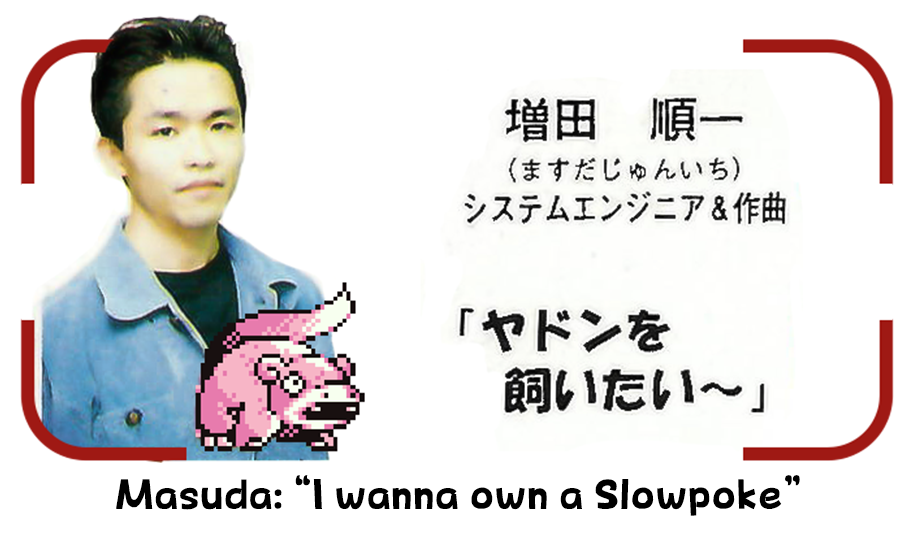
Tajiri: “By the way, this game took the longest to debug of any Nintendo game ever sold. Thanks for the help everyone. (laughs)”
Masuda: “I think for any game, annoying bugs are what players tend to remember the most. That’s why we were determined to root them out of the connection battles.”
Morimoto: “Originally we didn’t plan to implement link battles, so there were lots of little things that needed to be revised.”
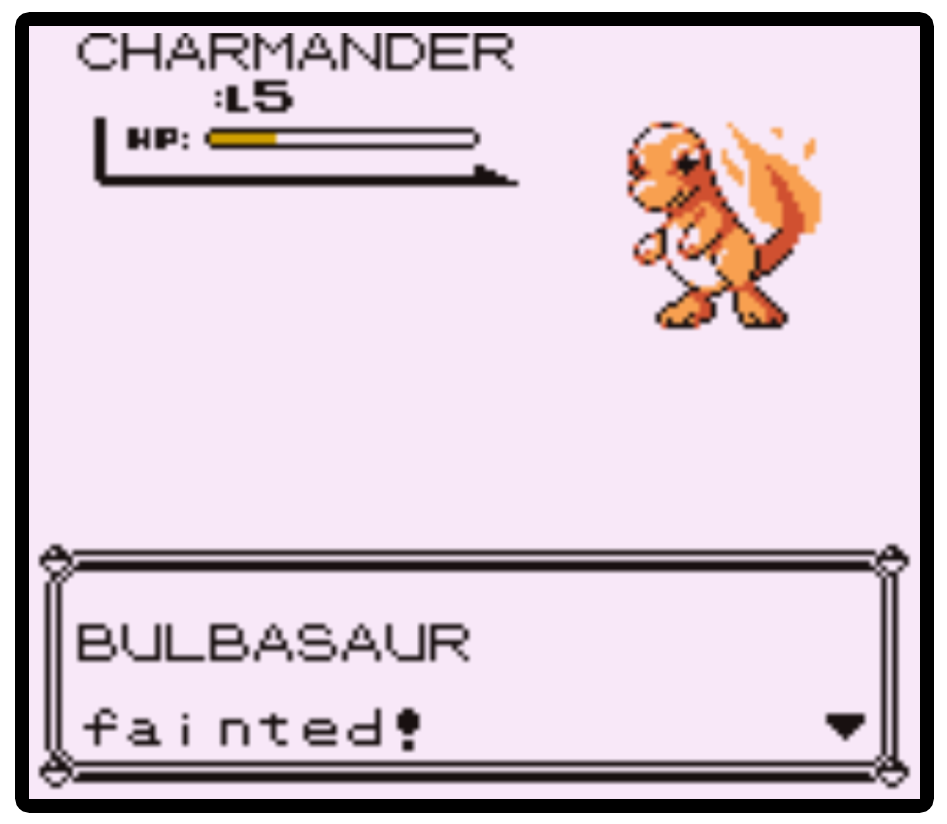
Dr Lava’s Notes: Another fascinating “what if” scenario — just imagine if Pokemon battles were something you watched in a few seconds, instead of commanded for a few minutes. And no link battles either. Pokemon was almost entirely about collecting, buying, and trading Pokemon… and battles were just the smallest afterthought. Somewhere in the multiverse, there’s a reality where that’s Pokemon is. It’d be an entirely different game, but if they did it right, it could actually be pretty interesting.
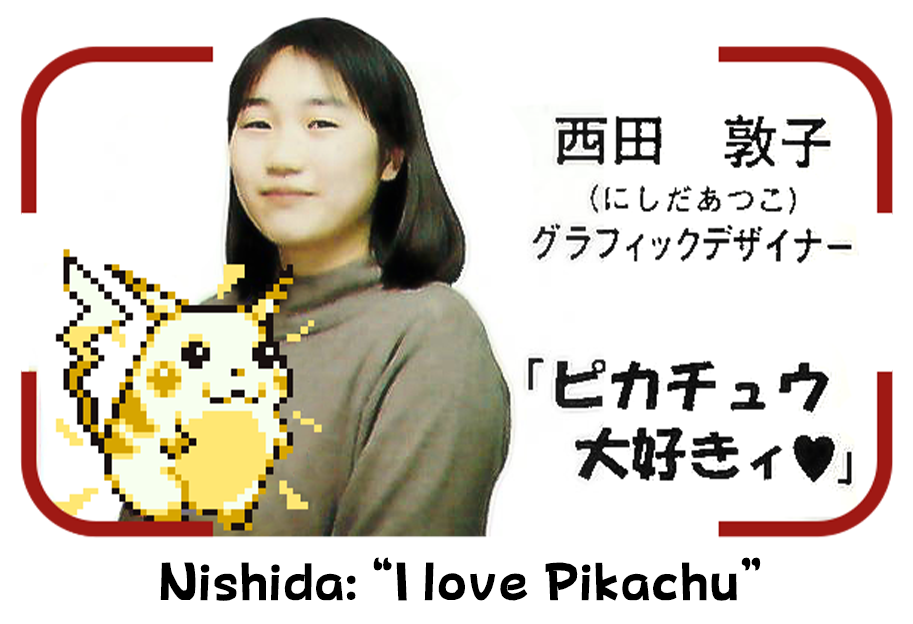
The Joy of Seeing Our 150 Children Grow and Evolve
“So are there any other interesting facts you’d like to discuss about this game?”
Tajiri: “This is about opportunities to trade, but like we talked about before, I think there’s lots of reasons to trade. We were inspired by the cards and stickers we collected as kids. So people will want to trade to get something rare or something they want. We also thought, what if something cool happens when you trade — so we’ve added 4 Pokemon that only evolve by trading. By the way, there are animals that ‘evolve’ in real life too, like how a caterpillar becomes a chrysalis, then a butterfly. When you trade — that is to say, when you let them go — they evolve. This way, we get people to trade all kinds of Pokemon, not just rare ones. After all, people are hesitant to give up something rare.

Oota: “It’s okay to think of trading not only as ‘giving,’ but it can also be for ‘lending.’ We want people to lend Pokemon just to complete their Pokedex as well. Just in case there was no benefit to the lender, we made it so traded Pokemon earn 1.5x more EXP. Pokemon also have unique ID numbers to prevent them from getting mixed up and lost.”
Watanabe: “Also, Pokemon have records of their Original Trainer’s name, and we made it so only the Original Trainer can change a Pokemon’s name. It wouldn’t be cool if the Pokemon you worked so hard to raise had its name changed. (laughs)”
Tajiri: “Even though Pokemon are simply a collection of numbers and code, we want people to feel like they’re living creatures moving from one Game Boy to another.”

Final Message from the Staff!!
Tajiri: “You can take the monsters you’ve raised wherever you go. I think that’s a great way to make people care about a game. There’s lots of Pokemon and moves for you to combine any way you want for unlimited ways to play.”
Masuda: “Please listen to all the different cries the Pokemon make. Try playing without headphones at least once.”
Sugimori: “Please look at these Pokemon sprites I worked so hard drawing. Trade with friends as much as possible and try to find them all!”
Oota: “After the first time you beat the game, I think you’ll enjoy figuring out who’s your favorite Pokemon for your next playthrough.”
Morimoto: “Try playing around with different moves and abilities, the results will be interesting. My recommendation is the move Metronome.”
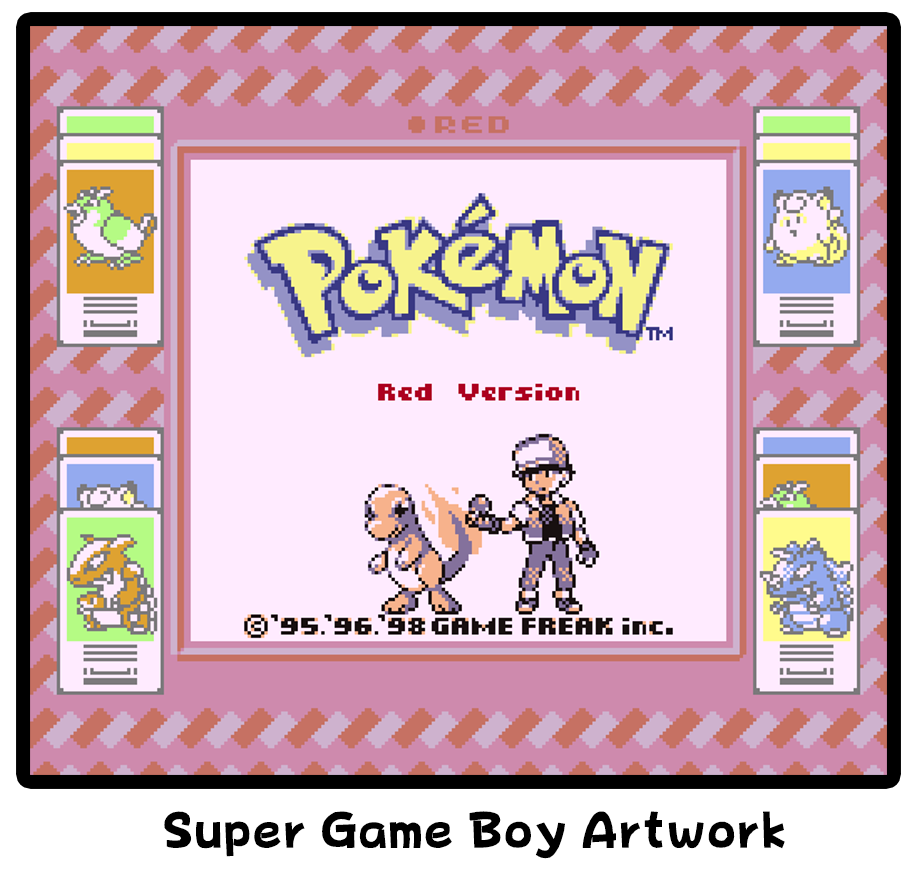
Watanabe: “Actually, I drew some of the art that surrounds the screen, so try playing on the Super Game Boy to see it.”
Fujiwara: “Try to beat the game first, but remember that it’s not the true ending. Your real objective is completing your Pokedex.”
Nishino: “It may get hard at times, but I want you to try your best to collect all 150 Pokemon.”
Nishida: “The battles are fun, but don’t worry too much about winning or losing. I want you to love and take care of your Pokemon.”

Closing Comments
Okay, that brings us to the end of Pokédex‘s 8 page developer interview. Pretty much the entirety of this book has also been translated — mostly lore-related — which can be found here. For lots more development interviews, check out this site’s homepage, and if you’ve already read all of them, check out my Patreon for about 10 more translations of rare old Pokemon interviews. Lots more translations are currently in progress — books, magazines, and even a couple issues of manga — so check back regularly. Thanks again for all y’all’s support, this work wouldn’t be possible without you.
Read More Pokemon Translations:
• Interview: Tajiri and Ishihara Discuss Game Freak Gefore Pokemon
• Developer Blog: Pokemon Anime Was Written Under the Influence
• Interview: Sugimori and Masuda on Gen 1’s Development
Videos About Pokemon History:
• Translation: Sugimori Explains Gen 5 Beta Pokemon
• Cut Content: Gen 4 and 5’s Scrapped Lock Capsule Event
• Cut Content: Gen 4’s Internal Data and Cut Content

